The takeaway message from prime minister Boris Johnson’s speech at the Conservative Party’s autumn conference was: “Let’s get Brexit done, and bring this country together.”
In one form or another, this has been the keynote of the conference all week, so it was no surprise that Johnson’s speech comprised a 45-minute elaboration of it. The Spectator’s James Kirkup has analysed the “genius” of this slogan. It echoes public exhaustion over Brexit, and promises to return British politics to the normality of domestic policy debates.
It has been clear for some time that the Conservatives intend to fight an election along the lines summarised in this slogan – and Johnson’s speech signalled only more strongly that the Tories are offering voters a post-Brexit promise of a United Kingdom built on “One Nation” policies. But there were further hints of the party’s election strategy in this speech too.
Reclaiming the “One Nation” brand
Brexit was not completely sidelined, of course, but Johnson omitted details of his plan for the Irish border, releasing it later in a more replete document. He also explicitly adopted the May-era mantra of “taking back control of our money, our borders, and our laws”. Otherwise, domestic policy dominated – public services in particular.
Johnson claimed that the Conservatives are the real party of the NHS, praised public sector staff, emphasised progress in schools, and recruitment in policing and health. He pointed to recent wage increases, and looked forward to “ending injustice” in social care.
On crime and drug offences Johnson touched upon sentencing, following home secretary Priti Patel’s hardline speech the day previously. But he also urged attention to investment in rehabilitation and in prevention. He spoke of building brownfield housing projects near to jobs and the importance of getting young people onto the property ladder. And of course he enthused over public transport, especially his beloved buses.

There were, however, mistakes. The disadvantage of relying in part on improvisation (apparent or real), audience participation, and the filler technique of “bumbling”, is that words such as “capitalism” and “NHS” can find themselves in uncomfortably close juxtaposition. There was also enough impromptu talk of the brilliance of London to fuel long-running complaints about politicians’ obsession with South-East – a narrative that is especially powerful in Scotland, Wales, and much of the North of England, where Johnson is seeking votes.
But such displays of public clumsiness are of course part of this prime minister’s style. Much has been made of his strong and allegedly unparliamentary language in recent weeks. But political rhetoric is an instrument upon which many tunes can be played – and it is entirely consistent with his style that the tune be intense and forceful. It is natural, too, that this will offend the ears of those whose preferred rhetorical style is that which privileges moderation and technicality.
True to form, Johnson described Labour as “fratricidal” and “antisemitic”, and again attacked the “surrender bill” intended to prevent a no-deal Brexit. Domestically Labour offered, Johnson said, “deranged and ruinous plans borrowed from the playbook of Bolivarian, revolutionary Venezuela”. Labour planned to “expropriate” school property, “stamp out” excellence in education and plunge the country into “total national discord”. And, rather than warn against the possibility of a Jeremy Corbyn premiership, Johnson deployed sharp ridicule, lampooning the Labour leader as a “communist cosmonaut”.
The strategy
All this may seem to be very conventional, albeit highly exaggerated, “Punch and Judy” politics. But the content weighting of Johnson’s speech reveals not only that the Conservatives are acting as if the general election campaign has already begun, but also signals their election strategy.
Significantly, the Liberal Democrats were hardly mentioned. It suits the Conservatives that left-leaning hardline Remainers feel implicitly encouraged to abandon the Brexit-equivocating Labour Party at the next election and to vote for the Liberal Democrats instead. If that happens, then the Conservatives could profit significantly from the second part of their plan, which is to target those marginals outside of London where Labour has been alienating and losing its pro-Brexit supporters.
The strategy involves, first, taking a simple and immediate position on Brexit, which ought to win back previous Labour defectors to UKIP and the Brexit Party. And no keen-eyed analyst could have missed the Conservatives’ new graphic, visible in the conference hall on boards and lapel stickers. Comprising the words GET BREXIT DONE in large white capital letters on a red square, it borrows heavily from the former branding of both Vote Leave and Labour.
Then, second, the party is tacking to the left with an optimistic tone and generous funding promises for the NHS, schools and the police.
Johnson is also positioning himself as a patriotic anti-establishment people’s champion, mocking parliament – which he compared to a broken laptop – and reiterating his own “passionate belief in our country”.
But Labour is still blocking the general election that Johnson wants – and an election campaign has a certain lifespan. Much depends on timing: voters tire of slogans that become clichés (just ask Theresa May), and the longer a campaign lasts, the longer critics have to poke holes in election pledges. Senior Conservatives may have to remind their new leader not to peak too early.

